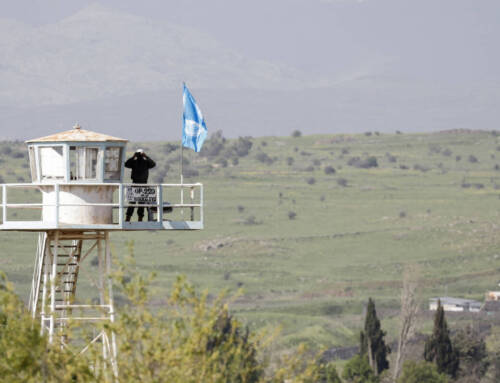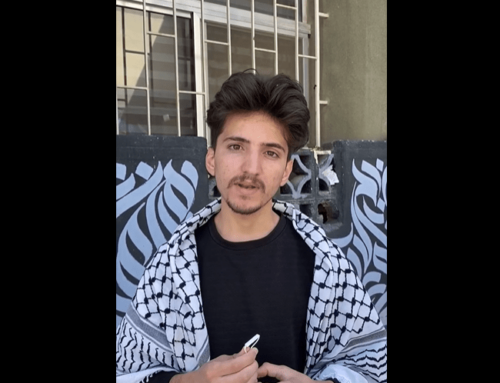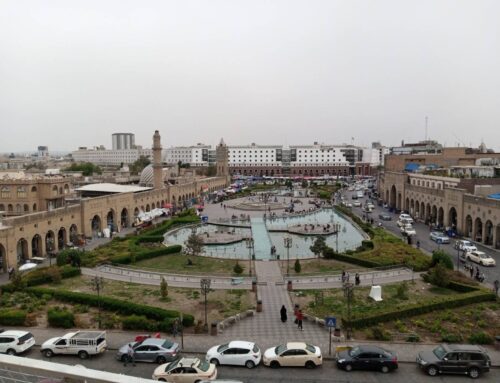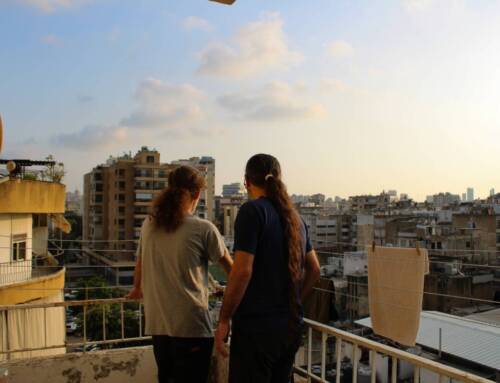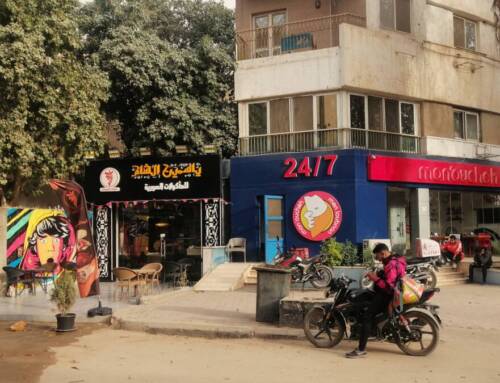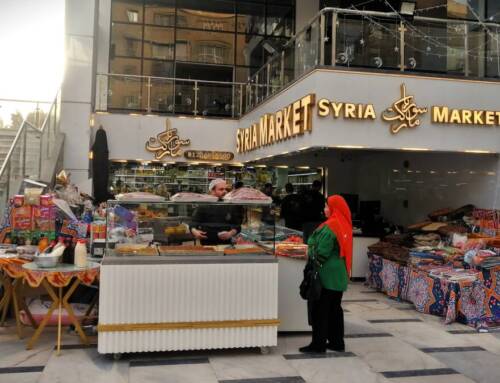Fear and uncertainty in Daraa: Is reconciliation over?
Can the reconciliation agreements survive Daraa's brewing insurgency and the government's heavy-handed tactics to crush it?
15 May 2020
Syrians ride a bicycle past destroyed buildings in an opposition-held neighborhood of the southern city of Daraa on October 2, 2018 (AFP)
AMMAN — Once again, the southern province of Daraa has found itself at the center of Syria’s popular protests as its residents demonstrate against the presence of Iranian militias and the possibility of a new military operation by the government forces in the province.
On Wednesday night, dozens of protesters took to the streets of the city of Tafas, in the western countryside of the province, to denounce Iranian-backed militias in the area, as well as the growing presence of Syrian government forces on the outskirts of the city in recent days. Simultaneously, dozens of protesters gathered in front of al-Omari Mosque in Daraa city, in solidarity with Tafas.
Damascus has been sending a steady stream of reinforcements to the western countryside of Daraa province and threatening to launch a military operation in the area, largely in response to the killing of nine Internal Security (police) officers in the town of Muzayrib on May 4. The killings were carried out by a former opposition commander who accused the regime of kidnapping and killing his son and son-in-law.
The “Central Committee of Daraa”—a committee formed to negotiate the final implementation of the Russain-mediated “reconciliation” agreement between the opposition factions of Daraa and the government in Summer 2018—condemned the killing of the policemen and called for the perpetrators to be prosecuted, in addition to starting negotiations with the government’s security and military agencies to contain the consequences of the incident.
“Over the last few days, the committee met with Brigadier-General Loai al-Ali [head of the military security branch in Suwayda province], Major-General Hussam Loqa [head of the Security Committee in southern Syria] and other commanders from the intelligence and military branches to solve this problem,” a member of a negotiation committee in western Daraa told Syria Direct on Tuesday, under the condition of anonymity for security reasons.
According to the negotiation committee member, the military commanders said that “the decision to storm the area had come from the highest authorities who are quite serious about the military operation,” and that “when the commanders of the military campaign arrive, we must sit and negotiate with them.”
He added that “new military reinforcements came to the outskirts of the western countryside of Daraa yesterday [Wednesday], as well as to the outskirts of the city of Daraa, in addition to other reinforcements to the 52nd Brigade in eastern Daraa. The reinforcements are equipped with “heavy weapons and included soldiers from the 4th, 5th, 9th, 15th-Special Forces divisions.”
The arrival of military reinforcements to three fronts was interpreted by the source as indicative that “the upcoming military operation might not be confined to the western countryside of Daraa, but might also include other areas.” They added that “the regime feels as if there are areas out of its control, and the incident in Muzayrib is a pretext, though everyone knows that we condemned the incident and worked to prosecute the perpetrator.”
What will happen next?
“The goal of the current military buildup and [upcoming] campaign is to secure additional concessions that favor the regime in implementing the reconciliation agreement,” the committee member explained.
“The regime wants to take the weapons out of the hands of the settlement [former armed opposition] factions in the area, in addition to arresting people who it views as obstacles to imposing control over the area. And perhaps there are also other goals related to the Iranians,” the source said.
To fulfill these goals, it is likely that the Syrian government will repeat “the July 2018 scenario,” that led to seizing southern Syria, according to the source, “when it offered us a reconciliation agreement that we turned down and, consequently, [the government forces] started an extremely violent military campaign that brought us to the negotiation table under the pressure of Russian fighter jets.”
The fact that “the commanders of the military campaign have yet to meet with us indicates that the regime might resort to limited military action, and then begin a round of negotiations that leads to imposing its demands [on us].”
That scenario seems increasingly likely, given the amount of reinforcements arriving, according to the member of the Central Committee of Daraa. “The military solution looks like the most likely [option] so far. The regime has reinforced its power to change the on-the-ground conditions and make more gains in the south.”
However, a former high-ranking military commander in a former opposition armed group in the western countryside of Daraa told Syria Direct that “the Sanamayn scenario has become the most likely for Tafas,” referring to an offensive by government forces and its allied militias launched in late February in the northern part of the town of al-Sanamayn, which was then under the control of opposition armed group. After capturing the city, the government forcibly transferred the fighters who refused the offered reconciliation deals to northern Aleppo province.
The response from the ground
“The regime restoration to a military solution will neither frighten us nor will it deter us from our demands and rights. In response to the military build-up, we will mobilize our revolutionary capabilities, strengthen our position in the street and prepare the people for what is to come,” said the member of the Central Committee.
They went on to add that “whoever makes the decision to intervene militarily will be wrong and will face repercussions throughout Houran [southern Syria]. Any forces that cross into [Daraa] will be considered hostile and Houran will not tolerate their presence in any area.”
The same was emphasized by a military source from the Russian-backed Fifth Corps, in the city of Busra al-Sham, in eastern Daraa. “We are with our people in Tafas, and against any crime that seeks to destabilize the security of the province. We are against the invasion of any area and reject any action that would provide a justification for the regime to invade any city,” the source told Syria Direct, adding that the Fifth Corps “will be side by side with our brothers and families.”
The negotiator from the western countryside of Daraa said that “any recklessness by the regime will take us back to square one,” revealing that the Central Committee had contacted the Russians, who are the guarantor of the 2018 reconciliation agreement, and “asked them to fulfill their promises and obligations,” adding that “today [Thursday] there is supposed to be a meeting with the Russians.”
The Iranian factor
Four sources who spoke to Syria Direct stressed that what they called “the Iranian wing” within the government’s forces and its security apparatus are “pushing” for a wide military operation in southern Syria. The “Iranian wing” consists of the 4th Division, led by Maher al-Assad; the 5th Division; the 15th Special Forces Division; and the Air Force Intelligence.
Iran’s goal, according to the sources, is to penetrate the strategic countryside of western Daraa due to its proximity to the Israeli border and the northwest Jordanian border.
On Thursday, civil and tribal activists issued a statement confirming that “the people and tribes of Houran stand united against what is going on” and that they condemn “the deployment of the army outside its barracks in order to intimidate, threaten, and provoke further hostility.”
The statement went on to add that “the hateful decisions to implement notorious sectarian agendas, especially by the Iranian militias … will find that their flimsy justifications and arguments will not be able to control the south, destabilize its security, or tears its social fabric by provoking strife and conflict.”
The future of the reconciliation agreements
In March, unknown assailants targeted a regime military checkpoint near the city of Jasem, west of Daraa. After the attack, the government’s security services threatened to storm the city and launch a broad military campaign.
Despite the continual presence of military reinforcements in the perimeters of the city, “things have calmed down after negotiations” with representatives of Daraa province, according to a former military commander affiliated with the opposition.
The source, speaking on the condition of anonymity for security reasons, told Syria Direct that “the future of the reconciliation agreements is connected to the future of Syria. In the near future, I think things will be good. But if there is no political solution, the situation will become dreadful because the logic of revenge persists with the regime.”
“Currently, the Russian position in the south is unclear. Contact with them is often over the phone, limited, and usually within the framework of their question about the general situation of the region.”
The report was originally published in Arabic and translated into English by Rohan Advani and William Christou


